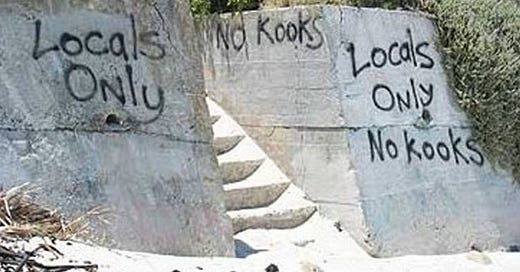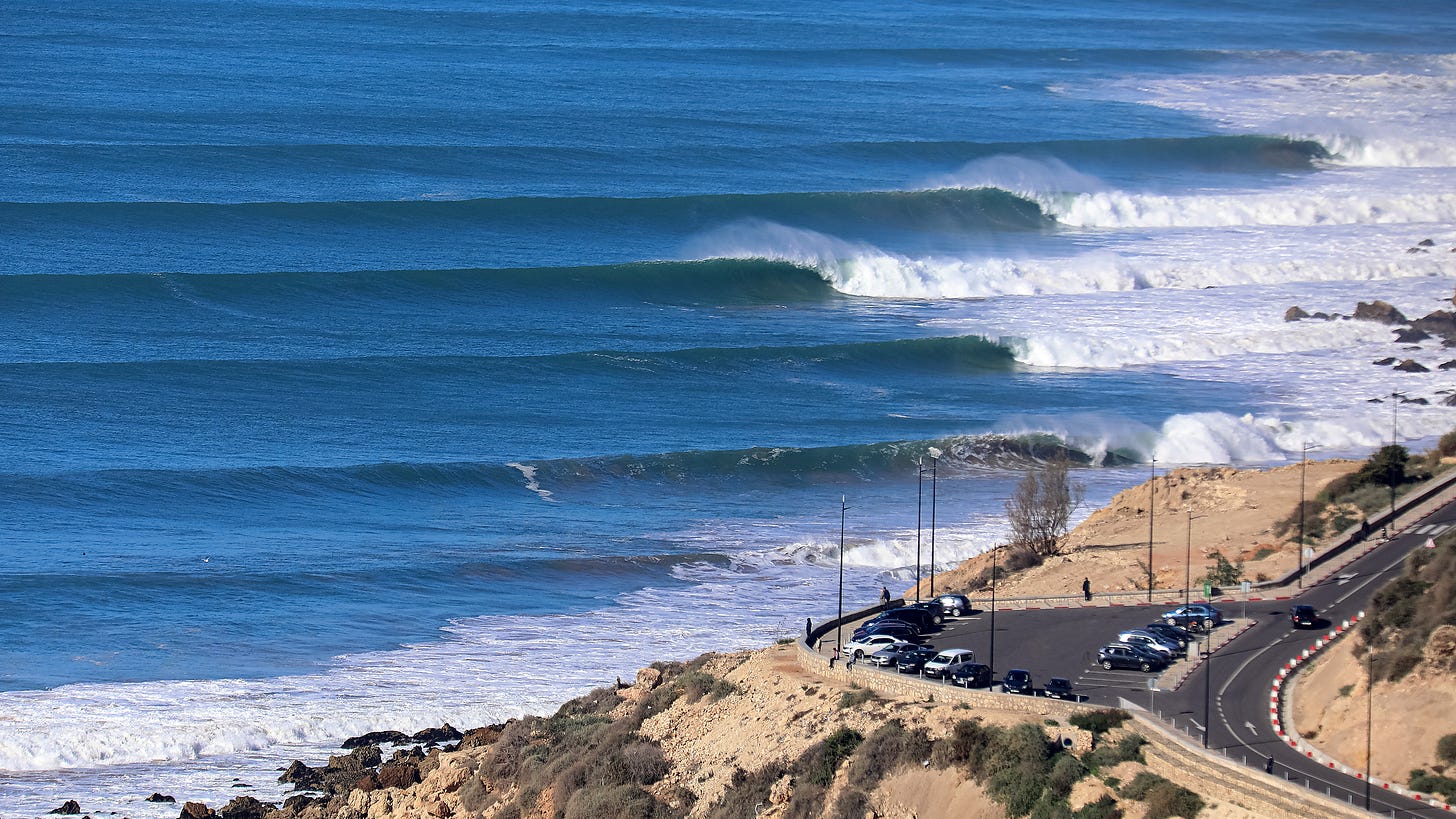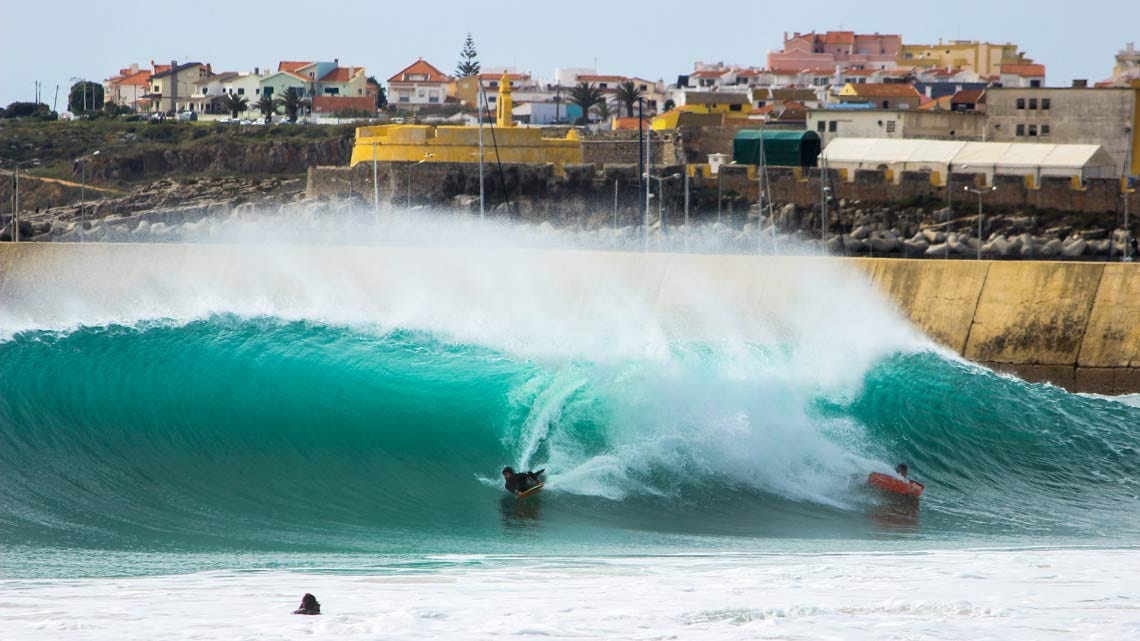When it comes to surfing, I’ve discovered non-surfers are interested in just three things: sharks, Nazare and localism. It makes sense. Sharks conjure an irrational fear, borne of their size, danger and movies like Starknado, Sharktopus and Megashark vs Crocosaurus. Nazare has waves 30 stories, or 100-foot, high breaking on a beach 100 yards from shore. It’s a geographical freak of nature that causes humans to gawp in wonder. Massive wave. Small human. Basic.
The last, localism, is less easy to understand or explain. Humans are drawn to the threat of violence. And non-surfers are surprised to find that that threat is ever-present in surfing. It has unwritten rules that need to be enforced, otherwise the system breaks down. In an ideal world, they are enforced with collective goodwill. More often they are regulated by a mix of time spent in the line-up, social standing, surfing ability and pure aggression. The thing is, it kinda works. Not perfectly, but weirdly efficiently. And yet, there are some spots where the balance is a little off-kilter. The aggression does the work of the goodwill and localism reigns supreme. Like these spots.
Mundaka
The famed Basque lefthander at Mundaka is the ideal Petri dish for fermenting a highly efficient form of localism. A world-class, highly photogenic rivermouth draws crowds from all over Europe and the world. It also needs a solid and just right direction swell that only comes in the colder months. Add a bathymetry that means, even on those rare swells, it only breaks properly for two hours on either side of high tide. Let's then throw in a dry-hair paddle out, and an outside peak and takeoff zone that is small enough to only nourish a pack of 20 surfers. Finally, there is the crowd - a hyper-talented, generally fearless and fiercely proud Basque pack of tubemongers who live for the wave.
The end result is that on a good Mundaka day, getting a set wave off the locals is practically impossible. On the plus side, violence is rarely in evidence, because it is very rarely required. Luckily, given the wave is around 350 yards long, visiting surfers can sit down the line, and with a fall, or the odd wide set, still snavel one of the best waves of their lives.
El Quemao, Lanzarote
Aged 24, I was once surrounded by eight bodyboarders, who encircled me and started kicking me in the head with their fins and then sent me in. My crime? I’d paddled out, solo, and took off on a set wave at El Quemao. Now I was young, foolish, and frothing. Oh, and Australian. A potent mix of ignorance. It was also eight feet, offshore and doing its mash-up of Pipeline and Lakey Peak. The sheer power and quality of the wave on Lanzarote had my lack of awareness dialled up to 11.
Its quality had me quickly forgetting the wave’s description in the Europe Stormrider Guide. “When it’s on, it’s packed with the best of the island’s stand-up surfers and bodyboarders and a Coliseum atmosphere pervades,” it said. “One of the most photographed spots in the Canaries, but also one of the most localised.”
My first adventure in what is known as the Hawaii of Europe and “key learning experience” was in the late 1990s, and neither the wave’s quality nor its breachability, has changed much since. The hard-charging, and talented locals do share their waves, but it takes years of dedication and beatdowns to establish your credentials. Otherwise, it's basically off-limits on the best days, leaving visitors to content themselves with the 30-odd reefbreaks in the nearby vicinity.
Safi, Le Jardin
Yes, not in Europe and very much in Africa, but the winter pilgrimage by European surfers to the righthand points of Morocco has a 50-year history, meaning we can slip this into the mix. As late as 25 years ago, localism wasn’t so much a factor, as the Moroccan surf scene was in its relative infancy. Now, with the incredible waves on offer and its history of surf tourism, Moroccans are both ripping and asserting themselves.
The wave at Safi La Jardin was first surfed in the mid-80s but has only entered the world surfing consciousness over the last decade. This is the wave where Ramzi’s backhand surfing has blown minds, and where Billy Kemper almost died. It is quite simply, one of the best sand-bottomed righthand points in the world, breaking for almost 500 metres, with mechanical perfection. A lack of current means the line-up isn't dispersed either. Yet it breaks infrequently, needing an XL, long period, swell, and is busy every time it does. The locals, knowing that they have a rare diamond in their midst, polish it accordingly. The pack sit on the outside peak, and even the best of visiting pros need to sit on the second peak, with drops in, rather than violence, the most common form of regulation.
"The vibes at Safi now are absolute shit," said local pioneer Moroccan charger Jerouyn Sahoun, "I now only surf at night."
Boucau, Les Landes
The waves of the southwest of France are well known for their quality, not so much for black short-inspired violence. In Hossegor, the swirling beachbreaks and ever-present rips make it hard to establish order in the line-up. It generally comes down to talent, with the best surfers getting the best waves. And there is no shortage of incredibly talented local Hossegor surfers.
However, a little further south lies Boucou, one of a few corners protected by more agricultural means. This wave’s defences are bolstered by it breaking next to a river groyne, which adds stability and order to the normal beachbreaks. This in turn makes much for a much smaller takeoff zone. Its quality and rare protection from certain winds, has however enticed visiting surfers, not always with positive outcomes. L'Équipe, the regional newspaper, wrote how Dane Reynolds once found his car tyres somehow flat in the carpark, and that the “Hobgood brothers and Bobby Martinez almost had to get down on their knees to shoot a few images.”
The newspaper cited the quality of the waves, its industrial landscape, and the local, working-class population as potential reasons why this wave has earned a reputation as being fiercely protected. The pros aren’t the only ones that have been ordered in or had their windscreen waxed over the years. Of course, good waves can be had there, and its reputation may be more steeped in historical lore rather than day-to-day fact. L’Equippe quoted local pro Tom Cloarec as saying, “If you know how to be discreet, everything will go well.”
Supertubos
Coxos is well known for its strong clique of local, talented surfers who guard one of Europe’s best waves (when it’s truly pumping) with a mix of superior knowledge, pure bravado and raw aggression. In the Algarve too, a few secret spots have been kept out of the spotlight with a strictly enforced no-filming policy and a few choice words to those who come with packed roof racks and loose lips. However, the consensus is that it is Supertubos and nearby break of Mohle Leste, that are probably the hardest nuts to crack. A key thread to all these waves mentioned is they are genuinely world-class. The quality of the waves, and the media attention they draw, bring visitors from all over the world. Accelerated by hosting a CT, Peniche has also had a huge boom in surf tourism over the last five to ten years. More surfers bring scarcity which begets tension, and localism, in all its forms, is a local surfer’s first, and most effective response. Add a rich surfing history dating back to the 1970s, and a bodyboarding culture as strong and storied as anywhere on Earth, and you can see why it’s almost impossible to rock up and get any set you like. The beachbreak nature of Supertubos does mean visitors can still get their fill (unlike the small takeoff zone next to the break wall at Mohle Leste) but here discretion remains the better part of valour.








Yes I agree Eloy- its a complicated issue. Surfing’s unwritten rules make it hard - there’s a lot of grey area for human kind to get involved and survival of the fittest brings out the worst in some people.
Hopefully more women in the line-up will help. And younger generation who won’t tolerate bullying etc. Surf could learn from the Skating and climbing communities, though the scarcity and overcrowding is less of an issue.
Nice content… but why localism exists on first place?
I found myself living more an alpine life than surfing life, despite I grew up in a very nice surf spot of south Spain, surfing, now I surf whenever I travel… I live now in the alps and close to dolomites in Italy and I found relief in the climbing community, a lot in common with surfing communities except localism, which does not exists…
My thesis, those locals are bad energy, bad vibes that need to be shown in the water, where they feel bigger than perhaps on land…
it should be forbidden and creating bad reputation in the same way someone yells on you in the car while driving…people should not be afraid of those, indeed, the gang supporting and imitating them are fucking scared, that is why the join them instead of ignore them…
Is a big pity to see localism breaking the good vibes in the water. Those people that most probably need therapy, are making surfing more sad, they do not understand the true meaning of surfing.
I do believe surfing needs regulation but it does not need to be enforced with violence.
I do believe there is enough for everyone to share despite small windows to surf…
People surfing in a red mind does not get what it gets to surf in a blue mind.